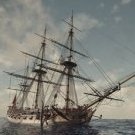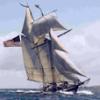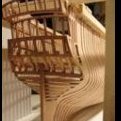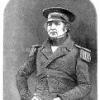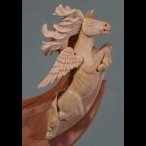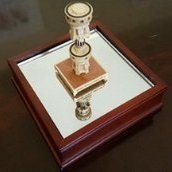Supplies of the Ship Modeler's Handbook are running out. Get your copy NOW before they are gone! Click on photo to order.
×
-
Posts
2,022 -
Joined
-
Last visited
Reputation Activity
-
 tlevine got a reaction from herask in HMS Atalanta 1775 by tlevine - FINISHED - 1:48 scale - from TFFM plans
tlevine got a reaction from herask in HMS Atalanta 1775 by tlevine - FINISHED - 1:48 scale - from TFFM plans
My general approach for fabricating and installing the beam sets has been one complete set at a time. This worked well where there was no curvature of the hull but I had difficulty with the run of the outer carlings at the fore end of the upper deck and decided to change my approach as I neared the stern. I set out all of the beams and tack glued them in place. I then drew fair lines for the outer carlings. The deck beams were removed as I worked on them, only mortising the outer carlings. The carlings were then tack glued without gluing the beam. This continued until the last two beams. The transom knee abuts the for end of the transom and extends along the hull just past beam 20. It is set down on to the deck clamp and "bolted" to the frames and transom. The last two beams are mortised into the transom knee.
The pictures show the run of the lateral carlings. No finish shaping or sanding has been done yet. I broke off the port counter timbers (again!) and just stuck it back on so that area looks out of whack. I will probably have to remake it when it comes time to make the counter.
-
 tlevine got a reaction from paulsutcliffe in HMS Atalanta 1775 by tlevine - FINISHED - 1:48 scale - from TFFM plans
tlevine got a reaction from paulsutcliffe in HMS Atalanta 1775 by tlevine - FINISHED - 1:48 scale - from TFFM plans
It has been a few weeks since the last update. Not that much has been accomplished because of that four letter word...work. I have all of the carlings temporarily installed, as well as the ledges between the carlings. I am still adjusting the height of the last two deck beams. The transom knee was made overly thick and now the top of the beams is lower than the top of the knee. The knee will be sanded down once I am happy with the fair run of the deck. Beam set 16 is completed. Only six more beams to go! The bracing across the outer counter timbers has been removed for the pictures. I decided not to build any more structures that stand proud of the deck until the deck is completed and sanded fair. The main mast partner kept getting bumped when I was truing the middle part of the deck. This should make sanding easier.
-
 tlevine got a reaction from Elmer Cornish in HMS Atalanta 1775 by tlevine - FINISHED - 1:48 scale - from TFFM plans
tlevine got a reaction from Elmer Cornish in HMS Atalanta 1775 by tlevine - FINISHED - 1:48 scale - from TFFM plans
It has been a few weeks since the last update. Not that much has been accomplished because of that four letter word...work. I have all of the carlings temporarily installed, as well as the ledges between the carlings. I am still adjusting the height of the last two deck beams. The transom knee was made overly thick and now the top of the beams is lower than the top of the knee. The knee will be sanded down once I am happy with the fair run of the deck. Beam set 16 is completed. Only six more beams to go! The bracing across the outer counter timbers has been removed for the pictures. I decided not to build any more structures that stand proud of the deck until the deck is completed and sanded fair. The main mast partner kept getting bumped when I was truing the middle part of the deck. This should make sanding easier.
-
 tlevine got a reaction from Jeronimo in HMS Atalanta 1775 by tlevine - FINISHED - 1:48 scale - from TFFM plans
tlevine got a reaction from Jeronimo in HMS Atalanta 1775 by tlevine - FINISHED - 1:48 scale - from TFFM plans
It has been a few weeks since the last update. Not that much has been accomplished because of that four letter word...work. I have all of the carlings temporarily installed, as well as the ledges between the carlings. I am still adjusting the height of the last two deck beams. The transom knee was made overly thick and now the top of the beams is lower than the top of the knee. The knee will be sanded down once I am happy with the fair run of the deck. Beam set 16 is completed. Only six more beams to go! The bracing across the outer counter timbers has been removed for the pictures. I decided not to build any more structures that stand proud of the deck until the deck is completed and sanded fair. The main mast partner kept getting bumped when I was truing the middle part of the deck. This should make sanding easier.
-
 tlevine got a reaction from jerry_bee in HMS Atalanta 1775 by tlevine - FINISHED - 1:48 scale - from TFFM plans
tlevine got a reaction from jerry_bee in HMS Atalanta 1775 by tlevine - FINISHED - 1:48 scale - from TFFM plans
It has been a few weeks since the last update. Not that much has been accomplished because of that four letter word...work. I have all of the carlings temporarily installed, as well as the ledges between the carlings. I am still adjusting the height of the last two deck beams. The transom knee was made overly thick and now the top of the beams is lower than the top of the knee. The knee will be sanded down once I am happy with the fair run of the deck. Beam set 16 is completed. Only six more beams to go! The bracing across the outer counter timbers has been removed for the pictures. I decided not to build any more structures that stand proud of the deck until the deck is completed and sanded fair. The main mast partner kept getting bumped when I was truing the middle part of the deck. This should make sanding easier.
-
 tlevine got a reaction from Erebus and Terror in HMS Atalanta 1775 by tlevine - FINISHED - 1:48 scale - from TFFM plans
tlevine got a reaction from Erebus and Terror in HMS Atalanta 1775 by tlevine - FINISHED - 1:48 scale - from TFFM plans
It has been a few weeks since the last update. Not that much has been accomplished because of that four letter word...work. I have all of the carlings temporarily installed, as well as the ledges between the carlings. I am still adjusting the height of the last two deck beams. The transom knee was made overly thick and now the top of the beams is lower than the top of the knee. The knee will be sanded down once I am happy with the fair run of the deck. Beam set 16 is completed. Only six more beams to go! The bracing across the outer counter timbers has been removed for the pictures. I decided not to build any more structures that stand proud of the deck until the deck is completed and sanded fair. The main mast partner kept getting bumped when I was truing the middle part of the deck. This should make sanding easier.
-
 tlevine got a reaction from michael mott in HMS Atalanta 1775 by tlevine - FINISHED - 1:48 scale - from TFFM plans
tlevine got a reaction from michael mott in HMS Atalanta 1775 by tlevine - FINISHED - 1:48 scale - from TFFM plans
It has been a few weeks since the last update. Not that much has been accomplished because of that four letter word...work. I have all of the carlings temporarily installed, as well as the ledges between the carlings. I am still adjusting the height of the last two deck beams. The transom knee was made overly thick and now the top of the beams is lower than the top of the knee. The knee will be sanded down once I am happy with the fair run of the deck. Beam set 16 is completed. Only six more beams to go! The bracing across the outer counter timbers has been removed for the pictures. I decided not to build any more structures that stand proud of the deck until the deck is completed and sanded fair. The main mast partner kept getting bumped when I was truing the middle part of the deck. This should make sanding easier.
-
 tlevine got a reaction from Trussben in HMS Atalanta 1775 by tlevine - FINISHED - 1:48 scale - from TFFM plans
tlevine got a reaction from Trussben in HMS Atalanta 1775 by tlevine - FINISHED - 1:48 scale - from TFFM plans
It has been a few weeks since the last update. Not that much has been accomplished because of that four letter word...work. I have all of the carlings temporarily installed, as well as the ledges between the carlings. I am still adjusting the height of the last two deck beams. The transom knee was made overly thick and now the top of the beams is lower than the top of the knee. The knee will be sanded down once I am happy with the fair run of the deck. Beam set 16 is completed. Only six more beams to go! The bracing across the outer counter timbers has been removed for the pictures. I decided not to build any more structures that stand proud of the deck until the deck is completed and sanded fair. The main mast partner kept getting bumped when I was truing the middle part of the deck. This should make sanding easier.
-
 tlevine reacted to Dan Vadas in HMS Vulture 1776 by Dan Vadas - FINISHED - 1:48 scale - 16-gun Swan-class sloop from TFFM plans
tlevine reacted to Dan Vadas in HMS Vulture 1776 by Dan Vadas - FINISHED - 1:48 scale - 16-gun Swan-class sloop from TFFM plans
Thanks again Grant, Allan, Bug, David, Guy and Alex - your comments are very welcome .
Allan and David - I'm intending to fully mast and rig the ship (if I live that long ).
Entry Steps
There are six Entry Steps per side - I'm only fitting the Port side.
To avoid making yet another Molding Scraper (which would have been very difficult to use around the ends of the steps in any case) I've made each step in two pieces using English Box. I used a previously made scraper to shape the lower portions, along with needle files and Xacto knife.
The two steps on the black Wales have been stained with Ebony wood stain - real Ebony didn't like my scraper very much, too much chipping out happened when I tried it on a sample piece :
Each step needed a varying degree of bevel sanded into it's inboard face to match the shape of the hull at that point.
Danny
-
 tlevine got a reaction from avsjerome2003 in HMS Atalanta 1775 by tlevine - FINISHED - 1:48 scale - from TFFM plans
tlevine got a reaction from avsjerome2003 in HMS Atalanta 1775 by tlevine - FINISHED - 1:48 scale - from TFFM plans
It has been a few weeks since the last update. Not that much has been accomplished because of that four letter word...work. I have all of the carlings temporarily installed, as well as the ledges between the carlings. I am still adjusting the height of the last two deck beams. The transom knee was made overly thick and now the top of the beams is lower than the top of the knee. The knee will be sanded down once I am happy with the fair run of the deck. Beam set 16 is completed. Only six more beams to go! The bracing across the outer counter timbers has been removed for the pictures. I decided not to build any more structures that stand proud of the deck until the deck is completed and sanded fair. The main mast partner kept getting bumped when I was truing the middle part of the deck. This should make sanding easier.
-
 tlevine reacted to Remcohe in HMS Kingfisher 1770 by Remcohe - 1/48 - English 14-Gun Sloop - POF
tlevine reacted to Remcohe in HMS Kingfisher 1770 by Remcohe - 1/48 - English 14-Gun Sloop - POF
Thanks for the nice compliments.
Sure, if I can hire you to do the drafting of the furniture, as I love your drawings. So just send your idea's and we'll make it a joint effort.
The upper half of the cupboard as two features, one shelf for pots and one to hold plates, I got the idea of some pictures I found of galleys.
Remco
-
 tlevine reacted to Remcohe in HMS Kingfisher 1770 by Remcohe - 1/48 - English 14-Gun Sloop - POF
tlevine reacted to Remcohe in HMS Kingfisher 1770 by Remcohe - 1/48 - English 14-Gun Sloop - POF
Interesting discussion, unfortunately my NMM plans don't show the position of the lanterns.
Meanwhile I've made some storage space for the galley, I wasn't pleased with MKI
so I build MKII with thinner hinges and a working drawer. Behind it I'll make an open cupboard.
Remco
-
 tlevine reacted to mtaylor in Licorne 1755 by mtaylor - 3/16" scale - French Frigate - from Hahn plans - Version 2.0 - TERMINATED
tlevine reacted to mtaylor in Licorne 1755 by mtaylor - 3/16" scale - French Frigate - from Hahn plans - Version 2.0 - TERMINATED
Update time... Things have not been quiet in the shipyard.
I laminated the plans to some MDF and attached a strip of wood at the reference line. Also attached the stern framing to this so as not to mis-read any critical dimension.
The strip allows me to use the Ed Tool without any induced errors from having it canted slightly.
I've marked all the plans with appropriate reference marks and rescanned them all. Also broke up Version 1.0 in order salvage certain bits.. like everything along the centerline... bitts, grates, pin rails, pumps, capstan, etc., some or all of the deck beams but none of the deck planking. Also salvaged the mast steps and the stern framing. I'll use the stern framing for some references.
I'm currently cutting out with as much precision as I can muster, a new build board. I noted that on the old one, there were some frame notches that we either too deep or not deep enough. Stupidity on my part. I'll be re-using the previous version of the frame squaring jig (on the right in the picture).
Hopefully, in the next week or so, I can start cutting the keel, deadwood, and stem. Since the wood for framing won't be here until early May, I'm planning on building some sub-assemblies such as most of the deck furniture. I've located a local source of good birch plywood, and am considering Woodcraft or the local source for masting materials and some other items.
-
 tlevine reacted to EdT in Young America 1853 by EdT - FINISHED - extreme clipper
tlevine reacted to EdT in Young America 1853 by EdT - FINISHED - extreme clipper
Young America - extreme clipper 1853
Part 44 –Inboard members continued, Stern fairing and half-frame bolting.
Work continued on the iron strapping with some breaks to work on other things. Other things included installing wood members over the strapped areas. In the first picture a portion of the lower deck clamp is being glued to the frames.
The forward section of the upper deck clamp has been installed at the top of the strapped area. As soon as the clamps are removed when the glue has dried, these members are immediately bolted through the frames with copper wire bolts epoxied all the way through the hole, making an extremely strong connection.
In the next picture a section of bilge ceiling is being installed. These heavy members will fill the area up to the lower deck clamp.
There will also be a few strakes of bilge ceiling below the installed strakes. The iron strapping will also be extended down to the floor heads. The next picture shows one of these extensions. The break in these straps will occur behind frames and will not be visible.
The next picture shows additional deck clamp sections installed, including forward sections of the middle deck clamp.
All these members are epoxy bolted as described above.
Before progressing much further aft with the iron strapping, I wanted to get the aft half-frames bolted securely. They have been held in place since installation only by the end-grain glue joints. I did not want to risk breaking these with the hammering of the strap rivets. Before installing bolts on these frames they needed to be faired. This is easier before the copper bolts are in place.
In the next picture 80-grit sandpaper is being used on the feet of the cant frames to bring them flush with the deadwood.
In the next picture all of the cant and half frames have been faired at their feet. The cant frames, in their scores, end right at the bearding line line. However, the half-frames are not installed in scores but bolted directly to the deadwood. These were not faired to a feather edge at the line but were cut back to about a 3” thickness above the line. The triangular gap was covered with planking. It acted as a limber, or drainage channel, for water that would otherwise accumulate between frames and in the joints between the frames and the deadwood. This feature was evidently not included at the feet of the cant frames.
The next picture shows the feet of the half-frames being squared off above the bearding line.
There will be more to say later about the path of this water to the pumps.
With the model inverted it was a good time to fair the deadwood back to the rabbets in the keel and sternpost. The next picture shows a shallow gouge being used to rough out the shape above the keel rabbet.
This can be risky if not done carefully. In the picture the curl of shaving shows that the gouge is moving parallel to the keel using the pressure of my thumb. I find that cuts go easier at an angle to the edge, slicing the wood - and it is never a good idea to cut toward the rabbet. The gouge is moving in the same direction in the next picture – held as in the last picture with the left hand, in this case pulled gently with the right – always with very light cuts. Do not attempt this with a dull tool.
In the next picture a #0 cut riffler is being used to smooth out the gouge marks. This was followed by 120 then 220-grit paper.
The last picture shows the feet of the half and cant frames after the sanding.
With the final lines of the frame bottoms established the bolt holes were laid out and drilled. These are now ready for the bolts.
There is a lot more sanding to be done on the lower hull, but this much was sufficient to get the bolts in. Now for the other side.
Ed
-
 tlevine reacted to EdT in Young America 1853 by EdT - FINISHED - extreme clipper
tlevine reacted to EdT in Young America 1853 by EdT - FINISHED - extreme clipper
Young America - extreme clipper 1853
Part 43 – Bilge Ceiling, Iron Strapping
Historical Clipper Note: A number of different structures were installed inside clipper ship hulls to increase strength and help defeat hogging, the most serious structural threat to wooden ships apart from rot. Hogging is the tendency of hulls to droop at the ends. It resulted from the reduced buoyancy at the ends of ships as the flotation area of the hull got smaller. It was further aggravated by localized stresses as waves passed under the hull. This was a particular problem in clipper hulls that were very long and had very fine lines fore and aft.
In addition to large keelsons, weight reductions at the ends, moving foremasts aft and some features discussed in earlier posts, additional structural members inside the hull were also used. These varied from builder to builder. These included massive additional keelsons in the area of the floor heads, various forms of heavy ceiling timbers, long diagonal wood “pointers” and ironwork. From what we know of William Webb’s designs, he seemed to favor thick “bilge ceilings” – bands of heavy planking from below the lower futtock heads up to the lower deck clamps - rather than bilge keelsons or pointers.
An 8” to 7” thick bilge ceiling and iron strapping were the most likely combination used in Young America and that will be the configuration I will use on the model
After some deliberation – discussed in earlier posts – I finally decided to install the strapping on the inside of the frames. Although this is not known to be the original configuration, it is most likely based on some references and Webb’ practice on other ships.
The strapping was installed on the frames under the ceiling planking. Because installing the strapping requires some hammering on the frames to rivet the straps in place, I wanted to get a couple of ceiling strakes in place to make the frame structure stronger before beginning the strapping.
The first picture shows the first strake of the bilge ceiling being installed. These are 8” x 8” members bolted through the frames from a few feet above the floor heads decreasing in thickness to 7” up to the lower deck clamp
The strake being installed is at the heads of the lower futtocks. This strake and the others in the band, follow the curve of these futtock head joints. Fore and aft they converge under the lower deck clamp to form a sort of truss to resist bending of the hull. This was definitely the configuration when bilge keelsons were used and it is likely the bilge ceilings followed this practice. Once this line is set by the first strake the others above and below it will be installed.
The next picture shows a closer view of the bolting and one of the joint scarphs.
Copper wire bolts have been epoxied through the frames. The dark area is isopropanol used to wash off the epoxy – not yet dry. Epoxy will help assure that the wire will act as true through bolts. In practice these were iron, so they will be blackened before final finishing. The second bolt at each frame pair will be modeled using black monofilament.
The next picture shows the copper bolts coming through the frames outside.
These will be clipped off and sanded flush as part of the external fairing process. It can be seen that the bolts come through the lower futtocks just below the heads. I am considering leaving a few view ports on the exposed framing side of the hull. The bottom of these open areas would be at the floor heads, so the bolted inside members should provide plenty of strength around the openings. The tops of these openings will probably be at the middle deck clamps.
With a stretch of ceiling in place I was anxious to try out some iron strapping. The first picture shows the installation of a test area.
I decided I wanted no part of recessing all these into the frames. For the most part they will be covered with inboard planking and will only be visible between frames on the outside, through the view ports if installed, and down through unplanked deck areas.
The next picture shows a closer view of the straps and their fasteners.
I used .005” copper for the straps, cutting them to size with a paper cutter, and then stretching to straighten them. I considered using .010” strips but these would require recesses. The thinner material should not affect the planking glue joints. Planks will also be bolted so should be quite secure. The difference in thickness is virtually undetectable visually. The actual thickness would probably be somewhere between the two sizes.
The straps are held in place by copper rivets - 22 gauge copper wire – some through and some partially through as “blunts”. Like the real bolts, the heads are peened over to secure the strips. I initially tried to get all of the intersections on frames for bolting, hence some uneven spacing in this first area. I will not describe all the steps in detail – or the journey up the learning curve to get acceptable-looking straps.
These must of course be blackened before being planked over – to avoid glue spots that would interfere with the etching.
The next picture from outside the hull shows some strapping blackened using liver of sulfur solution. This will be the predominant viewpoint for this feature.
This picture shows some inevitable crossing of straps between frames. I doubt that I will try to rivet these intersections as was done in practice, except where they fall over a frame. A few strapping rivet heads can be seen on the outside of the frames.
The strapping will be installed over the full length of the hull up to the upper deck clamps. The next picture shows some correctly sized clamp material – for the lower and upper decks - temporarily held in place,
This shows the convergence of the ceiling and the lower deck clamp mentioned above. The 7 to 8” bilge ceiling would fill the area below the lower deck plank and continue for a few more strakes below those installed in this picture.
The straps will be cut off above the upper deck clamp. The strapping is fully extended forward in this picture. The middle deck clamp will fall midway between the two shown.
I now foresee a considerable amount of strapping work, punctuated with some bilge ceiling and perhaps deck clamp installation. Should be interesting.
Ed
-
 tlevine reacted to Rustyj in Bomb Vessel Granado by Rustyj - FINISHED - 1:24 - cross-section
tlevine reacted to Rustyj in Bomb Vessel Granado by Rustyj - FINISHED - 1:24 - cross-section
Thanks Ben and Floyd!
Putting aside the temptation to stick every piece of wood, plastic and metal in
the lathe and "turn it" I've placed the mortar in it's carriage.
Here she is set to be stowed.
And here it is set in firing position.
Now I can move on and attempt to turn some cannon barrels!!!!!!!
-
 tlevine reacted to Trussben in HMS Pegasus 1776 by Trussben - 1:48 - Swan-class sloop based on TFFM
tlevine reacted to Trussben in HMS Pegasus 1776 by Trussben - 1:48 - Swan-class sloop based on TFFM
Work on the sternpost has begun, complicated lining up with aft deadwood but moving along slowly is fine by me.
Ben
-
 tlevine reacted to DORIS in ROYAL CAROLINE 1749 by Doris - 1:40 - CARD
tlevine reacted to DORIS in ROYAL CAROLINE 1749 by Doris - 1:40 - CARD
Hello dear friends,
I am touched by your comments, your words and praise mean a lot for me. Thank you very much for your support and comments. That is a great honour for me and also a commitment to make things as best as possible to be worthy of your words.
On Royal Caroline I finished a small staircase and railing in front of the main cabin:
And there are also prepared all flags printed in a laser printer on the thin cloth - batiste (I have no such printer at home, but one of my friends helped me with printing).
The biggest flag is already placed on the flagpole:
-
 tlevine reacted to dcicero in 18th Century Longboat by dcicero - FINISHED - Model Shipways - 1:48 - Tri-Club
tlevine reacted to dcicero in 18th Century Longboat by dcicero - FINISHED - Model Shipways - 1:48 - Tri-Club
Last week was full of distractions and I got very little done on the longboat ... but what I did get done looks pretty good.
The forward platform went in just fine.
Making the risers was also pretty straightforward. I didn't complicate the scribing of the grooves. I just ran an awl against the edge of a ruler and scribed them in. A couple of passes was all it took to get some good looking grooves in them. (I did have one riser look a little more "fuzzy" than the other one. Don't know why, but it'll all sand out.)
The amount of edge bending needed was a little more than I had initially anticipated. It took two trips to the glass plate to get enough bend in the plank to get it to sit correctly against the frames with a consistent measurement from the top of the cap rail.
When I went to install the risers, I found that the forward platform was a little too high. When it was just the template sitting there it looked fine, of course. That operation wasn't that tough. I just made it a little smaller and sanded the frames a little bit more.
Once the platform was back in, the risers went in without a problem.
Then it was time to put in the locker bulkhead. Following the instructions, I made a template. The nice thing about using templates is the ability to alter them quickly and easily. I started out tracing the frame from the plans and then gluing that outline to a piece of cardstock. I cut out the template and found it was far too large to fit in the space behind the frame, so I cut it down ... too much. That was no problem because I just added another layer of cardstock and added in what needed to be replaced. That worked great.
Then I cut a piece of basswood to size and fitted it in place.
Now on to making the thwarts!
Dan
-
 tlevine got a reaction from Nirvana in 18th century Longboat by fnkershner (Floyd Kershner) - Model Shipways - 1:48
tlevine got a reaction from Nirvana in 18th century Longboat by fnkershner (Floyd Kershner) - Model Shipways - 1:48
I used castello boxwood for my planking. My approach was different from the kit instructions in that I spiled the planks in a more prototypical manner rather than attempting to edge-bend them. I did not have to soak any of the planks. The castello is a pleasure to work with. It holds an edge and there are no fuzzies after sanding. I did not apply a sanding sealer...a must if you are using the enclosed basswood.
-
 tlevine reacted to dcicero in 18th Century Longboat by dcicero - FINISHED - Model Shipways - 1:48 - Tri-Club
tlevine reacted to dcicero in 18th Century Longboat by dcicero - FINISHED - Model Shipways - 1:48 - Tri-Club
The aft platform is in ... and the forward one has been made and is ready for installation.
I saw The Lego Movie this weekend with the kids. (Don't laugh. It's really very good.) There's a lesson in the movie about following the instructions and how that's not always the best plan. Ignore that. Follow the instructions. Here's why.
Instead of following the instructions, which say to make the template then make up the blank for the platforms, I did the opposite. I looked at the photos, counted the number of planks I needed and made up the blank. Then, while the glue was drying, I made up a template to allow me to cut the blank to shape.
Bad plan because, in truing up the edges of the planks, I needed more planks to make a proper aft platform.
See? Not wide enough. I made another blank, wider this time, and everything worked out fine. I did make one, small alteration. When I glued the planks together, even though I let them set up under a weight, there was some bowing of the platform.
I put a small piece of planking material on the bottom of the platform, between the frames. That flattened it right out.
Here's the final result.
Dan
-
 tlevine reacted to EdT in Young America 1853 by EdT - FINISHED - extreme clipper
tlevine reacted to EdT in Young America 1853 by EdT - FINISHED - extreme clipper
Young America - extreme clipper 1853
Part 42 – Internal Hull Work
With the hull framing finished it was time to step back and consider the right construction sequence going forward. Rather than go to work fairing and sanding the outer hull as I has anticipated, I decided to focus next on some of the basic internal structural elements. Installing some key internal longitudinal members will add a lot of strength to the frames, in particular the connections of the full square frames at the keel. These joints are rather weak and may not stand up well to outside sanding. In practice this joint was strengthened by use of a very heavy garboard strake (the plank next to the keel) that was bolted up through the floors and lower futtocks. This 9” thick block was in turn edge bolted into the keel. The garboard was a much more important structural member in these ships than the familiar 18C RN subjects.
The first step was to fair out the inboard sides of the frames. The full square frames had been carefully checked for fairness before locking them forever into place when the keelson was installed. The careful pre-beveling of the half and cant frames and the use of the topside ribband to set these resulted in a pretty fair surface. A few had to be removed and reset.
The first picture shows the first sanding/fairing step using 120-grit paper and a “soft-sander” foam pad.
Once all the surfaces were faired out with the 120-grit paper, 220-grit was used to start smoothing the surfaces. In the next picture a round piece of a soft-sander pad is stuck to a vibrating sander and it turn has some 220-grit paper attached to that – all with two-faced carpet tape, A few different pad shapes were used.
This was followed by 320-grit, using the same device. There was also a lot of old-fashioned handwork with all this sanding.
In the next picture the wood is being given a final polish with #0000 steel wool.
I don’t like using steel wool very much – it leaves a lot of steel fibers lying around and this also adheres to steel tools. But after years of searching, I have found nothing that polishes bare hardwood like steel wool, so I am using it here - #1, then #0, then #0000. All the tools are cleared away before doing this and the shop-vac comes out frequently.
With the inside of the hull given its final polishing, the lines of the deck clamps were scored on the frames as shown in the next picture.
A thick pine batten was first clamped to the frames as shown. The heights of the clamps were taken off the inboard arrangement drawing with the calipers shown below. These will be familiar to those who followed Naiad.
To allow the measurements to be transferred to the inside of the hull a thin strip was taped on top of the original arm to fit through the frame gaps.
The next picture shows the batten set at the height of the middle deck. The lower deck clamps on both sides have been marked. The upper (or main) deck clamps will be just below and essentially parallel to the temporary ribbands clamped to the outside of the frames. When those clamps are installed, the outside ribbands can be removed
Removing the temporary ribbands and strengthening the framing with internal members will allow the outside of the hull to be completely faired and finish sanded from the keel up to the top rail.
In the next part members of the “bilge ceiling” will be installed below the line of the lower deck clamp.
Ed
-
 tlevine reacted to Remcohe in HMS Kingfisher 1770 by Remcohe - 1/48 - English 14-Gun Sloop - POF
tlevine reacted to Remcohe in HMS Kingfisher 1770 by Remcohe - 1/48 - English 14-Gun Sloop - POF
Thanks all.
Yuk Grant
Sure Daniel, the joints are tinted with graphite to enhance the joints. Otherwise the joints are almost invisible and the bulkhead will look like its made from one piece.
Time to make some lanterns, the mullions were completely prepared on the table saw assembling was quite simple, once complete they were sanded down to the appropriate thickness
Here they are temporary in place, I still need to add a vent but I'm not sure how long to make it, TFFM describes it should clear the deck head. Should it face away from the bulkhead or go up to the upper deck, some advice would be appreciated how I need to interpret this.
Remco
-

-
 tlevine got a reaction from paulsutcliffe in HMS Atalanta 1775 by tlevine - FINISHED - 1:48 scale - from TFFM plans
tlevine got a reaction from paulsutcliffe in HMS Atalanta 1775 by tlevine - FINISHED - 1:48 scale - from TFFM plans
My general approach for fabricating and installing the beam sets has been one complete set at a time. This worked well where there was no curvature of the hull but I had difficulty with the run of the outer carlings at the fore end of the upper deck and decided to change my approach as I neared the stern. I set out all of the beams and tack glued them in place. I then drew fair lines for the outer carlings. The deck beams were removed as I worked on them, only mortising the outer carlings. The carlings were then tack glued without gluing the beam. This continued until the last two beams. The transom knee abuts the for end of the transom and extends along the hull just past beam 20. It is set down on to the deck clamp and "bolted" to the frames and transom. The last two beams are mortised into the transom knee.
The pictures show the run of the lateral carlings. No finish shaping or sanding has been done yet. I broke off the port counter timbers (again!) and just stuck it back on so that area looks out of whack. I will probably have to remake it when it comes time to make the counter.


